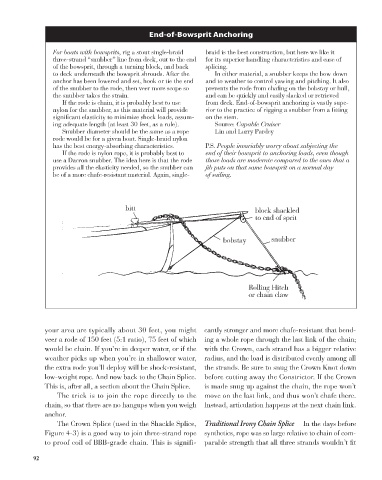Page 113 - The Complete Rigger’s Apprentice
P. 113
End-of-Bowsprit Anchoring
For boats with bowsprits, rig a stout single-braid braid is the best construction, but here we like it
three-strand “snubber” line from deck, out to the end for its superior handling characteristics and ease of
of the bowsprit, through a turning block, and back splicing.
to deck underneath the bowsprit shrouds. After the In either material, a snubber keeps the bow down
anchor has been lowered and set, hook or tie the end and to weather to control yawing and pitching. It also
of the snubber to the rode, then veer more scope so prevents the rode from chafing on the bobstay or hull,
the snubber takes the strain. and can be quickly and easily slacked or retrieved
If the rode is chain, it is probably best to use from deck. End-of-bowsprit anchoring is vastly supe-
nylon for the snubber, as this material will provide rior to the practice of rigging a snubber from a fitting
significant elasticity to minimize shock loads, assum- on the stem.
ing adequate length (at least 30 feet, as a rule). Source: Capable Cruiser
Snubber diameter should be the same as a rope Lin and Larry Pardey
rode would be for a given boat. Single-braid nylon
has the best energy-absorbing characteristics. P.S. People invariably worry about subjecting the
If the rode is nylon rope, it is probably best to end of their bowsprit to anchoring loads, even though
use a Dacron snubber. The idea here is that the rode those loads are moderate compared to the ones that a
provides all the elasticity needed, so the snubber can jib puts on that same bowsprit on a normal day
be of a more chafe-resistant material. Again, single- of sailing.
bitt block shackled
to end of sprit
bobstay snubber
Rolling Hitch
or chain claw
your area are typically about 30 feet, you might cantly stronger and more chafe-resistant that bend-
veer a rode of 150 feet (5:1 ratio), 75 feet of which ing a whole rope through the last link of the chain;
would be chain. If you’re in deeper water, or if the with the Crown, each strand has a bigger relative
weather picks up when you’re in shallower water, radius, and the load is distributed evenly among all
the extra rode you’ll deploy will be shock-resistant, the strands. Be sure to snug the Crown Knot down
low-weight rope. And now back to the Chain Splice. before cutting away the Constrictor. If the Crown
This is, after all, a section about the Chain Splice. is made snug up against the chain, the rope won’t
The trick is to join the rope directly to the move on the last link, and thus won’t chafe there.
chain, so that there are no hangups when you weigh Instead, articulation happens at the next chain link.
anchor.
The Crown Splice (used in the Shackle Splice, Traditional Irony Chain Splice In the days before
Figure 4-3) is a good way to join three-strand rope synthetics, rope was so large relative to chain of com-
to proof coil of BBB-grade chain. This is signifi- parable strength that all three strands wouldn’t fit
92

